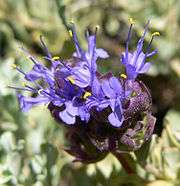Salvia dorrii
| Salvia dorrii | |
|---|---|
 | |
| Scientific classification | |
| Kingdom: | Plantae |
| (unranked): | Angiosperms |
| (unranked): | Eudicots |
| (unranked): | Asterids |
| Order: | Lamiales |
| Family: | Lamiaceae |
| Genus: | Salvia |
| Species: | S. dorrii |
| Binomial name | |
| Salvia dorrii (Kellogg) Abrams[1] | |
Salvia dorrii,[2][3] the purple sage,[2] Dorr's sage, fleshy sage, mint sage, or tobacco sage, is a herbaceous perennial in the family Lamiaceae. It is native to mountain areas in the western United States and northwestern Arizona, found mainly in the Great Basin Range habitat and southward to the Mojave Desert, growing in dry, well draining soils. Some large native populations of this species also are found in the Aquarius Plateau region of Southern Utah.

Description

Salvia dorrii is a woody subshrub reaching 1-3 feet in height and width. The grey-green leaves are narrow and lanceolate, are tapered at the base and rounded at the tip, and have a smooth and round margin. They are generally basal, and about 1-3 cm long. They have an intense but pleasant, mildly intoxicating minty aroma, with the scent released when the foliage is handled or crushed. The inflorescence is made up of spike-like clusters of numerous purple flowers that are bilateral. The flowers remain on the plants after being pollinated, with the desiccated flowers remaining for some weeks or months after flowering. The inflorescences have a strong resemblance to miniature purple-colored Pussy willows.[4][5]
Individual tobacco sage plants form large, heavily branched hemispherical mounds 3-4 feet across in sand drainage flats along Hole in the Rock Road southeast of Escalante, Utah. They can also be seen along the high, eastward-facing section of the Methuselah Trail in the Ancient Bristlecone Pine Forest of Nevada.
Ecology and reproduction
Salvia dorrii is an uncommon and locally rare plant with isolated populations throughout its range and requires well drained and dry soil, full sun, little water, and high summer temperatures. In Utah, it only occurs in restricted and isolated populations in steep canyons and arroyos near Moab, Utah and Escalante, Utah. It is considerably more common in Southern Utah and Northern Arizona. They occur on dry slopes in areas with sandy soils in drainage washes and banks of arroyos throughout the Mountain West which experience intermitment and very infrequent water throughout the growing season.
Uses and toxicity
Some chemical components found in Salvia dorrii include salvidorol and two epimeric abietane diterpenes.[6]
References
- ↑ "Salvia dorrii (Kellog) Abrams". ARS-GRIN. Retrieved 2008-03-10.
- 1 2 "Plants Profile - Salvia dorrii (Kellog) Abrams - (Purple Sage)". USDA.
- ↑ "Catalogue of Life : 2011 Annual Checklist : Salvia dorrii (Kellogg) Abrams".
- ↑ "Salvia Dorrii". Utah State University.
- ↑ Ward, B. J. (2004). The Plant Hunter's Garden: The New Explorers and Their Discoveries. Timber Press. ISBN 978-0-88192-696-5.
- ↑ Ahmed, A. A.; Mohamed, A. el-H. H.; Karchesy, J.; Asakawa, Y. (2006). "Salvidorol, a nor-abietane diterpene with a rare carbon skeleton and two abietane diterpene derivatives from Salvia dorrii". Phytochemistry. 67 (5): 424–428. doi:10.1016/j.phytochem.2005.12.009. PMID 16458943.
